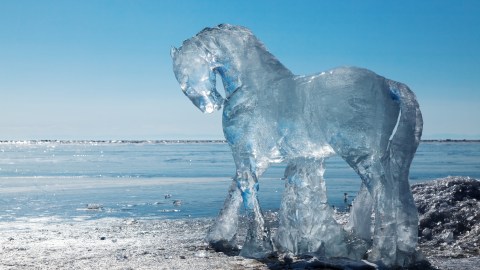The history of ice, one of the first luxuries

- The first recorded icehouse dates back over 4,000 years ago, from the Sumerians.
- Other ancient and classical civilizations, from the Persians to the Romans, had techniques for producing and distributing ice. Some of the same methods lasted up to the 19th century.
- References to ice remain rare in the ancient canon. Teasing such quotidian details from the canon is difficult, but with an eye for detail, we can learn much about how people lived in the distant past.
The first recorded icehouse dates to Year 13 of the rule of Shulgi, King of all Sumer and Akkad, builder of the Great Ziggurat of Ur, a date which would, by our reckoning, fall somewhere around 2081 b.c.e. We know the icehouse was a big deal because the Sumerians like to name each year after something significant that happened within it. Year 13 was the year of the icehouse. It is described in the surviving cuneiform tablets as being twice as long as it was deep, and insulated with branches of tamarisk.
What we cannot know is whether this was Shulgi’s innovation, or whether ice pits had been built previously, perhaps even before the founding of the Sumerian civilization. But if it was his or his engineer’s idea, it would take more than 4,000 years for the use of ice to become as unremarkable as it is today. Yet historical sources for it remain limited perhaps because, even then, it seemed ordinary.
This is a fundamental obstacle with history: it is fickle. That thing we might be interested in might not have been of interest to the ancient writer. In the case of Sumer, the clay tablet we might hope to tell us what we hope to know could simply have been ground into dust by time. Or, in the case of more Classical texts, the papyrus scroll of our needs may simply not appeal to its copyist. So much knowledge has been lost. So many books by famous and important ancient writers we know of simply do not survive. Take, for example, our sources for no lesser figure than Alexander the Great: while we know that contemporary historians wrote about him, their works never made it through the centuries. While these works were cited by historians like Arrian and Quintus Curtius Rufus, they wrote at least 400 years after the events they described. This complicates things for those of us today who might wish to discern what really happened so very long ago.” Looking into this distant past we, like Louie Kamookak, are detectives, but with even less to go on.
Nevertheless, we can still perhaps trace a through line of ice storage and usage from these distant times at least as far as the Classical era. References to icehouses dry up after Shulgi’s momentous achievement, returning to the tablets some two hundred years later, when icehouses are recorded in Mari, a Bronze Age kingdom in eastern Syria. The question we cannot answer is whether there might have been an exchange of ice technology between the Ur of Shulgi and the Mari of Zimri-Lim. Given the volume of correspondence that survives from the Near Eastern Bronze Age, we must consider it a possibility, not least because of the this tantalising fact: Shulgi was married to a woman named Taram-Uram, the daughter of Apil-Kin,Shulgi’s contemporary and ruler of Mari.
Mari grew up on a trade crossroads between Mesopotamia and Babylon. Not only is it considered to be one of the earliest planned cities, it was also a center of technical innovation. Its people were great canal builders, both for irrigation and navigation, constructing one that ran 126 km past the city, allowing traders a more direct route that bypassed the long and winding Euphrates. The icehouses crop up towards the end of Mari’s time of influence, the late nineteenth century b.c.e., when the city was ruled by the so-called Lim Dynasty.
History does not seem to have run smoothly for the Lims. Their first ruler, Yaggid-Lim, successfully passed the throne to his son, Yakhud-Lim. Despite various successes, including expanding his city-state’s irrigation and refortifying his wall, Yakhud-Lim found himself becoming vassal to the more powerful city of Aleppo, then of the Mesopotamian city Eshunna, and then, having reasserted his independence one more, at war with the Assyrians. All this before being assassinated by his son.
That would have been that for the Lim Dynasty were it not for Zimri-Lim, Yaggid-Lim’s apparent grandson, in approximately 1776 b.c.e. And it is to Zimri-Lim that we must turn to find our ice.
Having cemented his relationship with Aleppo by marrying its king’s daughter, Zimri-Lim sought to restore Mari to its former glory. He did so through diplomacy, marrying his daughters to neighboring kings, allying with the powerful kingdom of Babylon to his south, and, thanks to the frequent letters exchanged with his married-off daughters, keeping himself abreast of everything around him through what is best described as a familial intelligence network. His vast archive of correspondence and official records was uncovered by archaeologists in the 1930s. Written in Akkadian, the official language of Near Eastern diplomacy, these tablets—more than 22,000 of them—shine an extraordinary light into the life and workings of the Syrian mid-Bronze Age. And it is one of these tablets, the so-called Tablet of Zimri-Lim, now housed in the Louvre, that tells of the foundation of an icehouse in Terqa, not far from Deir ez-Zor on the banks of the Euphrates.
It seems that the Terqa icehouse was not unique. Zimri-Lim claims to have built similar icehouses across his kingdom. But, while we know from the tablets that they existed, we have no idea what they looked like, how they were stocked with ice, nor how they were maintained. Our best guess suggests that they might have been similar to later examples built by the Persians. This would seem to make sense. Though the surviving ancient Persian icehouses, called yakhchals, were built around 400 b.c.e., much later than the those of Zimri-Lim, there is no reason that their technology should not have existed a good 1300 years later. A yakhchal works by evaporative cooling. In the dry desert air, the temperature drops fast after sunset, often going below freezing at higher altitudes. The yakhchal’s domed structure allows this cold air to pour inside and into the pit within, while the conical walls draw warmer air up and out. In addition, the structure is built of a particular mortar called sarooj, made to a specific recipe that includes sand, goat hair, clay, egg whites, ash, and lime. It is both water resistant and an excellent insulator.
A yakhchal gives you ice and cold food storage under specific regional conditions — were there higher humidity here, it simply wouldn’t work — and those conditions exist on the site of Mari. But, though it seems highly likely, we cannot know if the two cultures used a similar or the same technical idea to make their ice. There is a missing link between them in the chain of ideas, so we cannot connect them. We can only suppose.
Nor can we connect the Persian use of ice with that of Ancient Greece. We know, for example, that snow was available in the markets of late fifth century b.c.e. Athens. There is a story recounted by the rhetorician Athenaeus about the comedian Diphilus, whose many plays only survive in fragments, in which he attends a dinner at the house of a woman called Gnathaena where the wine is cooled with snow sent by one of her lovers. We know, too, from Chares of Mitylene, that when Alexander came to Petra after his conquest of Nabataea, he ordered the construction of ice pits, to be filled with snow and protected with oak branches. Lacking the climactic conditions that allowed the Persians to build their yakhchals, the Greeks took a different tack to storing the cold. We find it described in Plutarch, though the pits he records were covered with straw and cloth.
Similar techniques were practiced in Italy from the Roman period into the nineteenth century. In his book The History of Ancient and Modern Wines, Alexander Harrison quotes a Mr. Lumsden, who describes the collection of snow for use in Rome at a site known as Hannibal’s Camp:
“On this dry plain they dig pits, without any building, about fifty feet deep, and twenty-five broad at the top, in the form of a sugar loaf, or cone. The larger the pit, the snow, no doubt, will preserve better. About three feet from the bottom they commonly fix a wooden grate, which serves for a drain, if any of the snow should happen to melt, which otherwise would stagnate, and hasten the dissolution of the rest. The pit thus formed, and lined with pruning of trees and straw, is filled with snow, which is beat down as hard as possible, till it becomes a solid body. It is afterwards covered with more prunings of trees, and a roof is raised in form of a low cone, well thatched over with straw.”
So, not wildly dissimilar to Alexander’s pits at Petra.
Ice so stored was then sold in shops or hawked on the streets of Ancient Rome, much to the disapproval of Seneca who, in his work Naturales Quaestiones, lamented its use as a “true fever of the most malignant kind.” Sniffy old Seneca aside, ice was a serious luxury business, even if its transportation from store to city often caused it to be spoiled with dirt, which led to the invention, described by Pliny the Elder, of a vessel in which previously boiled water could be surrounded with this snow, without contamination, and left to freeze.
Such references to ice remain rare in the ancient canon. But this should not make us think that the thing they describe was rare as well, even if it was not available to everyone. We have to tease the quotidian from our ancient sources. The everyday is most often mentioned as an aside, for it is something the intended reader already knows and doesn’t need explaining to them. As L. P. Hartley wrote, the past is a foreign country, and we — the unintended readers — are frequently left to deduce from scant evidence just how differently they did things there.





